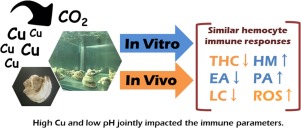Aquatic Toxicology ( IF 4.1 ) Pub Date : 2018-08-02 , DOI: 10.1016/j.aquatox.2018.08.003 Xizhi Huang , Xiaoyu Jiang , Meng Sun , Sam Dupont , Wei Huang , Menghong Hu , Qiongzhen Li , Youji Wang

|
With the development of industry and agriculture, the metal pollutants (e.g., Cu) are inevitably released into the aquatic environment. In addition, ocean acidification (OA) as a major environmental stress is affecting marine organisms. In this study, we investigated the hemocyte responses of the estuarine oyster Crassostrea rivularis exposed to six combinations of two pH levels (8.1 and 7.7) and three Cu concentrations (0, 10 and 50 μg/l) using flow cytometry in vitro and in vivo. In both experiments, Cu and low pH jointly affected the hemocyte parameters of oyster. High Cu exposure resulted in decreased total hemocyte count (THC), esterase activity (EA) and lysosomal content (LC) and increased hemocyte mortality (HM), phagocytosis activity (PA) and reactive oxygen species (ROS) production, especially under low pH conditions. The immune suppression of metal-exposure was more significant than low pH exposure with a 28-d experimental period in oysters. A slight recovery of the immune parameters was observed in THC, HM, PA, ROS and LC. During the depuration period, the modulatory effects of pH were still obvious. In addition, carry-over effects of high Cu and low pH were still observed. Overall, our results showed that copper and low pH weaken immune functions of hemocyte in oysters, with synergistic effects. This work provides new evidence of sublethal negative effects of metals on marine animals under global change scenarios, and copper likely leads to reduced fitness of oysters under low pH conditions.
中文翻译:

低pH条件下铜对河口牡蛎Crassostrea rivularis血细胞参数的影响。
随着工业和农业的发展,金属污染物(例如铜)不可避免地释放到水生环境中。另外,作为主要环境压力的海洋酸化(OA)正在影响海洋生物。在这项研究中,我们调查了河口牡蛎Crassostrea rivularis的血细胞反应在体外和体内使用流式细胞仪检测两种pH值(8.1和7.7)和三种Cu浓度(0、10和50μg/ l)的六种组合。在两个实验中,铜和低pH值共同影响牡蛎的血细胞参数。高铜暴露导致总血细胞计数(THC),酯酶活性(EA)和溶酶体含量(LC)降低,以及血细胞死亡率(HM),吞噬活性(PA)和活性氧(ROS)产生增加,尤其是在低pH条件下条件。在牡蛎中,经过28天的实验,金属暴露的免疫抑制作用比低pH暴露更为重要。在THC,HM,PA,ROS和LC中观察到免疫参数略有恢复。在净化期间,pH的调节作用仍然很明显。此外,仍然观察到高铜和低pH的残留效应。总体而言,我们的结果表明,铜和低pH值会削弱牡蛎血细胞的免疫功能,并具有协同作用。这项工作提供了新的证据,表明在全球变化的情况下,金属对海洋动物具有致命性的负面影响,而铜可能会导致在低pH条件下降低牡蛎的适应性。











































 京公网安备 11010802027423号
京公网安备 11010802027423号